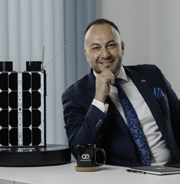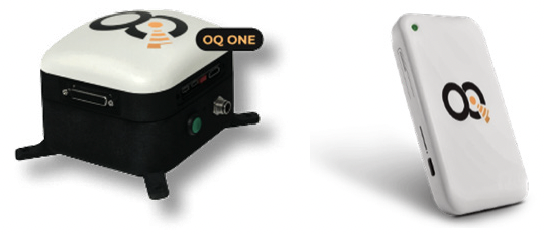Omar Qaise worked at the European Space Agency, the German Aerospace Center and OHB Systems as a spacecraft engineer, concentrating on deep space and telecommunication missions.
He then joined SES and O3b, where he sold more than $100 million in satellite solutions and services over a four-year period of time. While exposed to the energy sector, Omar realized how poorly the needs of industrial IoT users were being addressed. He learned about CubeSats, which were already successful with Earth Observation, and wanted to bring them into telecommunications.

After having reviewed the different available technologies addressing IoTs, he concluded that no one had cracked the wireless technology in the field and he decided to launch OQ Technology, dedicated to shaping the future of satellite mobile connectivity.
From your perspective, Mr. Qaise, what problem were you originally setting out to solve when you founded the company? How has that mission evolved as the satellite telecommunications landscape has changed?

Omar Qaise
When I founded OQ Technology in 2016, the central problem I wanted to address was the vast connectivity gap on Earth, particularly for IoT devices and machines operating in remote or underserved regions.
Working with organizations such as the European Space Agency and SES Satellites, I observed firsthand that conventional terrestrial infrastructure, such as fiber and cell towers, simply couldn’t reach certain areas efficiently.
I realized that the satellite industry had tremendous potential but remained constrained by high costs, proprietary hardware, and a lack of standardization. My vision was to leverage the same mobile technologies that power 3G, 4G, and 5G smartphones into the satellite world, enabling affordable, scalable, and global connectivity.
Since then, the landscape has evolved significantly. Standards like 3GPP Release 17 introduced support for non-terrestrial networks, creating an opportunity to harmonize terrestrial and satellite communications. The rise of Direct-to-Device (D2D) connectivity has made it feasible to connect billions of devices without changing hardware, lowering costs tenfold in some cases.
Our mission has, therefore, expanded: we’re not just connecting remote sensors—we’re building a hybrid network that seamlessly integrates terrestrial cellular networks with our Low Earth Orbit (LEO) satellites, ensuring constant connectivity for IoT, smartphones, and mission-critical applications.
The problem has evolved from “how do we connect the unconnected?” to “how do we provide reliable, affordable, standardized, and global hybrid connectivity that scales with tomorrow’s digital economy?”
Your company recently expanded its LEO constellation and launched new services. Can you discuss how these milestones strengthen OQ Technology’s position in the global satellite market, and what differentiates your approach to satellite 5G from other players in the field?
Omar Qaise
Expanding our LEO constellation and launching new services represents a pivotal moment for OQ Technology. Today, we have 10 satellites on-orbit, with plans to deploy 82 more in the future.
This growth allows us to provide uninterrupted global coverage, connecting devices that move in and out of cellular networks, such as those in maritime shipping, logistics, and energy sectors. By building a constellation that is compatible with standardized NB-IoT protocols, we immediately scale to billions of devices without requiring specialized hardware, a major differentiator from traditional satellite operators, who often rely on costly proprietary chips and infrastructure.
Our approach to satellite 5G focuses on hybrid connectivity. We’ve developed single-SIM solutions that allow devices to seamlessly switch between terrestrial and satellite networks. This interoperability reduces deployment costs, lowers barriers to adoption, and ensures continuity of service in remote or underserved regions.
Additionally, OQ Technology prioritizes spectrum access and technology standardization, which positions us as a trusted partner for Mobile Network Operators (MNOs) such as Deutsche Telekom and Telefónica.
While many operators are reactive, we’ve anticipated the convergence of mobile and satellite networks, giving us an edge in the emerging direct-to-device ecosystem. Ultimately, our growth milestones reinforce our technical capabilities as well as our vision of a connected Earth, where machines, vehicles, and humans remain online, regardless of their geography.
How do you see OQ Technology’s role in building hybrid connectivity solutions, and what does this mean for industries such as energy, maritime, logistics, or defense that rely on robust communications?
Omar Qaise
OQ Technology’s role is to bridge the gap between terrestrial networks and satellites, enabling what we call hybrid connectivity. Industries such as energy, maritime, logistics, and defense rely on real-time communication, yet conventional networks often leave critical blind spots.
Our hybrid solution ensures that IoT devices, machinery, and even smartphones remain connected regardless of location. By combining LEO satellites with terrestrial 5G networks, a single SIM allows seamless switching between networks, reducing downtime and operational risk.

For the energy sector, this means oil rigs and pipelines in remote areas can transmit real-time data for predictive maintenance. In maritime logistics, vessels can report location and cargo status continuously, even in mid-ocean. Defense operations benefit from resilient communication links that are harder to disrupt, while disaster response teams can coordinate rapidly in regions where infrastructure is damaged or nonexistent.
Our technology goes beyond connectivity—it integrates AI at the edge to support real-time decision-making. For example, monitoring environmental conditions or identifying potential hazards in real-time becomes feasible. The combination of hybrid networks and edge intelligence transforms traditional operations into smart, adaptive ecosystems.
Ultimately, OQ Technology is not just providing a network, it’s creating the foundation for industries to operate more efficiently, safely, and sustainably in a connected world.
What trends do you see as most significant for the future of satellite communications over the next five to ten years, and where do you see OQ Technology leading or contributing most strongly?
Omar Qaise
Several trends are set to define the next decade in satellite communications.
First, D2D connectivity will continue to scale, connecting smartphones, IoT devices, and sensors without specialized hardware. Second, hybrid networks that integrate LEO satellites with terrestrial 5G will become the standard for uninterrupted global connectivity. Third, AI and edge computing in satellite networks will enable real-time decision-making, transforming industries from logistics to disaster response.
Another significant trend is the commercialization of space itself. Satellite technology is no longer the domain of governments alone; private players are innovating rapidly, reducing costs, and enabling more flexible solutions. Additionally, European sovereign infrastructure will gain importance, particularly as satellites are increasingly recognized as critical infrastructure susceptible to cyber threats. Initiatives such as IRIS² highlight the growing emphasis on resilience and security, and OQ Technology is at the forefront, offering direct-to-smartphone and IoT connectivity while securing spectrum and patents critical for scaling.
OQ Technology’s strength lies in standardization, hybrid connectivity, and rapid deployment. We are leading the industry by making satellite networks interoperable with existing cellular systems, allowing global coverage at unprecedented scale and cost efficiency.
By combining spectrum access, LEO constellation growth, and AI-enabled services, we are positioned to drive the transition from sporadic connectivity to continuous, intelligent communication networks worldwide.
Building and scaling a satellite company requires navigating complex partnerships and global regulations. What leadership strategies have been most effective for you in building relationships, securing trust, and expanding internationally?
Omar Qaise
Leadership in satellite telecommunications requires a combination of technical expertise, strategic foresight, and relationship management. One of the most effective strategies I’ve adopted is transparency. When we engage with partners, regulators, or investors, we are upfront about capabilities, timelines, and challenges. This builds trust, which is crucial when dealing with complex regulatory environments and cross-border operations.
Secondly, I prioritize collaboration. Satellites are rarely built or operated in isolation. Partnerships with MNOs, launch providers, and regulatory bodies are essential. For example, our collaboration with Telefónica leverages their terrestrial network, while OQ Technology provides NB-IoT satellite coverage, creating mutual value. Globally, we approach relationships with respect for local regulations and cultural contexts, adapting our solutions while ensuring alignment with our mission.

Finally, resilience and adaptability are core leadership principles. The space industry is unpredictable, with delays, technical setbacks, and regulatory hurdles. Leading by example, showing commitment, and celebrating incremental successes inspires teams and reassures stakeholders. International expansion is supported by this mix of technical credibility, transparent communication, and adaptive problem-solving.
By combining these strategies, OQ Technology has been able to grow a global footprint, navigate spectrum licensing, and build confidence in both commercial and governmental partners.
Your personal career spans engineering, business development, and entrepreneurship. How has this blend shaped your leadership philosophy, and what lessons do you prioritize when guiding your team?
Omar Qaise
I lead OQ Technology with a foundation built on engineering, business development, and entrepreneurship. Engineering instilled in me precision, systems thinking, and the rigor required to solve complex problems. Business development sharpened my understanding of market dynamics, partnership building, and the strategic foresight needed to scale technology globally. Entrepreneurship taught resilience, adaptability, and the power of a clear mission to inspire teams to imagine and achieve ambitious goals.
When guiding my team, I prioritize curiosity, collaboration, and vision. Curiosity drives continuous innovation, collaboration acknowledges that no one person builds a satellite system alone, and vision provides a shared roadmap that aligns every action with our mission.
Resilience is essential, mistakes are inevitable, but learning and iterating quickly is critical. Adaptability allows the team to pivot as markets, technology, and regulations evolve, without losing sight of long-term objectives.
This combination of technical rigor, market awareness, and entrepreneurial drive ensures OQ Technology remains agile, innovative, and mission driven. It fosters a culture where people are empowered to contribute meaningfully and collectively shape the future of global satellite connectivity.


